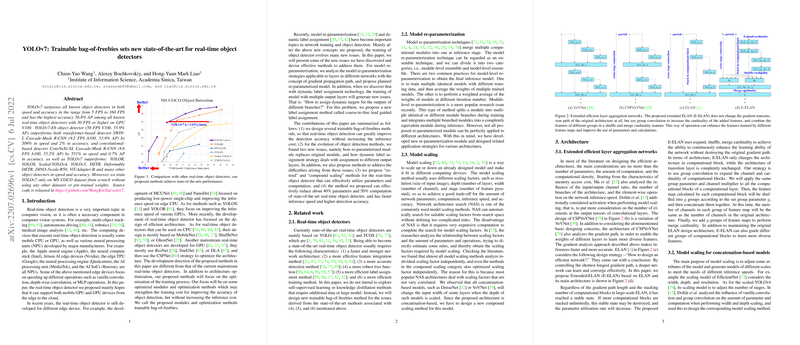YOLOv7: Trainable Bag-of-Freebies Sets New State-of-the-Art for Real-Time Object Detectors
The paper "YOLOv7: Trainable bag-of-freebies sets new state-of-the-art for real-time object detectors" presents a novel approach to advancing real-time object detection by leveraging the YOLOv7 framework. This work, authored by Chien-Yao Wang, Alexey Bochkovskiy, and Hong-Yuan Mark Liao, introduces several novel methodologies and optimizations that synergize to deliver superior performance in terms of both speed and accuracy across varying hardware and computational environments.
Summary and Key Contributions
YOLOv7 marks a substantial leap in object detection by integrating a series of optimizations referred to as trainable bag-of-freebies and introducing key architectural enhancements. The primary contributions of this paper can be itemized as follows:
- Trainable Bag-of-Freebies:
- Planned Re-parameterized Convolution: This technique addresses the integration of re-parameterized modules into different network architectures, maintaining the integrity of gradient flow paths.
- Coarse-to-Fine Lead Guided Label Assigner: This novel label assignment strategy dynamically adjusts label assignments for auxiliary and lead heads, enhancing the training efficiency and inference accuracy.
- Optimization Techniques: Incorporates batch normalization integration, implicit knowledge from previous YOLO versions, and EMA models.
- Extended Efficient Layer Aggregation Networks (E-ELAN):
- E-ELAN is an enhancement over traditional layer aggregation networks, optimized using group convolutions and cardinality-based feature merging, which preserves the gradient transmission paths while enriching the features learned across network layers.
- Model Scaling for Concatenation-Based Models:
- Introduces a compounded model scaling methodology which simultaneously adjusts the depth and width scaling factors, tailored specfically for concatenation-based architectures.
- Performance Milestones:
- YOLOv7 demonstrates a remarkable performance improvement over contemporary models, including YOLOX, YOLOR, PPYOLOE, and variants of YOLOv5 and YOLOv4, as well as transformer-based models and convolutional networks.
Numerical Results and Evaluations
The performance metrics and comparisons outlined in the paper substantiate the efficacy of YOLOv7 across multiple benchmarks. Key results include:
- Accuracy and Speed: YOLOv7 achieves 56.8% AP on the MS COCO dataset at 56 FPS on a V100 GPU, outperforming SWIN-L Cascade-Mask R-CNN by 2% in accuracy and 509% in speed, and ConvNeXt-XL Cascade-Mask R-CNN by 0.7% accuracy and 551% speed.
- Parameter and Computation Efficiency: YOLOv7 models demonstrate significant reductions in parameters and computations without compromising detection accuracy.
- Ablation Studies: The paper rigorously evaluates the impact of each proposed method, such as the planned re-parameterized modules and coarse-to-fine label assignment strategies, confirming their effectiveness in boosting model performance.
Practical and Theoretical Implications
Practically, the innovations introduced in YOLOv7 can be directly applied to improve real-time object detection systems across various domains such as autonomous driving, robotics, and medical image analysis. The unique "trainable bag-of-freebies" offers a pragmatic approach to enhancing model performance without additional inference costs, thus making it feasible for deployment in resource-constrained environments.
Theoretically, the concept of re-parameterization and dynamic label assignment opens new avenues for research in network architecture design and machine learning training methodologies. The compound model scaling approach also prompts a rethinking of scalability considerations for concatenation-based models, potentially influencing future design strategies in neural network research.
Speculations on Future Developments
Given the substantial advancements presented in YOLOv7, future developments in AI and object detection may focus on further refining these methodologies. Potential areas of exploration include:
- Extension of re-parameterization techniques across different types of neural architectures.
- Optimization algorithms for more efficient label assignment in varied contexts.
- Enhanced model scaling techniques that consider additional factors such as layer-specific optimizations or multi-objective scaling strategies.
These avenues not only seek to push the envelope of real-time object detection further but also aim to generalize the principles of efficient neural network design and training across broader AI applications.
In conclusion, YOLOv7 represents a significant technical achievement, offering a sophisticated blend of architectural innovation and practical optimizations. Its contributions are likely to influence both the academic and industrial landscapes of object detection technology.
